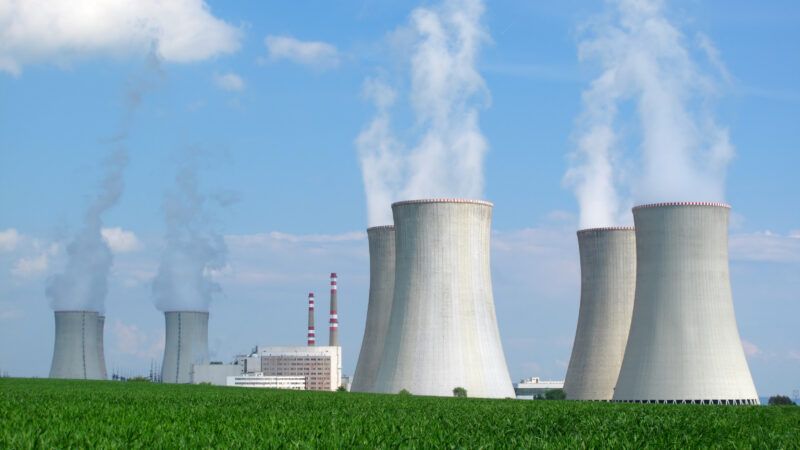Is COP28 the 'Nuclear COP'?
Instead of opposing nuclear power, climate activists should be thronging the streets demanding a faster rollout.

Dubai, United Arab Emirates—"It's been a very good COP for nuclear energy," said Jonathan Cobb of the World Nuclear Association. He was referring to COP28, this year's United Nations summit on climate change, which had given his industry several reasons for optimism. Most notably, 22 countries—including the United States, the U.K., France, Japan, and South Korea—had issued the ministerial Declaration to Triple Nuclear Capacity by 2050.
"COP28 will be known as the nuclear COP," Australia's shadow climate minister, Ted O'Brien, declared on one panel. And America's climate envoy, former Secretary of State John Kerry, proclaimed when the declaration was announced that "you can't get to net zero in 2050 without nuclear power."
"Net zero" is the condition where the anthropogenic emissions of greenhouse gases are balanced by removal from the atmosphere—one of the targets set by the Paris Climate Change Agreement. Kerry noted that nuclear energy currently supplies a third of the world's low-carbon electricity.
This increased recognition of nuclear energy as a climate-friendly power source builds on the progress I reported at last year's climate summit in Egypt. The declaration recognizes that "nuclear energy is already the second-largest source of clean dispatchable baseload power, with benefits for energy security." (Baseload means power generation that generally runs continuously throughout the year and operates at stable output levels. This contrasts with variable power sources, such as solar and wind: It isn't always sunny or windy.)
The countries issuing the declaration also "commit to supporting the development and construction of nuclear reactors, such as small modular and other advanced reactors for power generation as well as wider industrial applications for decarbonization." An example of those "wider industrial applications" would be the X-Energy small modular gas-cooled reactors Dow Chemical is using at its manufacturing plant on the Gulf Coast of Texas.
Another advantage of nuclear power plants is their relatively small size compared to the extensive and often remote areas needed to deploy wind and solar power. As Cobb pointed out, nuclear reactors can be slotted into the sites of decommissioned coal and natural gas power plants. The new nuclear power plants can run the already installed turbines and transmit the electricity they generate through already installed transmission lines. And the local communities are already set up to operate power plants.
As it happens, Terrapower announced earlier this year that it will build its advanced Natrium nuclear reactor near a retiring coal plant in Kemmerer, Wyoming.
All too predictably, various environmental groups at COP28 denounced the declaration. "Promoting a nuclear expansion at COP 28 is only a plan for climate failure," asserted Tim Judson, head of the U.S.-based Nuclear Information and Resource Service, in a press release. Lise Masson of Friends of the Earth International added: "We have no time to waste on such false solutions that only delay and distract real and adequate action to address the climate crisis."
These activists point out that it takes a long time to build a new reactor. Of course, these delays are largely the result of their own decades of support for crippling overregulation.
In a 2017 study in Energies, the Australian economist Peter Lang calculated that if the heavy regulation championed by anti-nuclear activists had not prevailed during the 1970s and '80s, nuclear power "could have replaced up to 100% of coal-generated and 76% of gas-generated electricity" globally by 2015. Had the earlier learning-curve trajectory been allowed to continue, nuclear power plant construction costs would be 10 percent of what they are now. This would have cut cumulative carbon dioxide emissions by 174 gigatons, and annual carbon dioxide emissions would now be one-third less.
About 440 nuclear reactors are operating now, with 60 more in construction and 110 more on the drawing boards. The goal of tripling nuclear energy production implies the construction of 880 new power plants by 2050. That would mean building an average of 34 new reactors every year from now til then.
Would that actually be enough? While nuclear power generates a significant amount of the world's electricity, it supplies only about 5 percent of the world's primary energy. Fossil fuels still account for around 80 percent of primary energy consumption. If you really want to cut greenhouse emissions over the course of this century, you'd need to increase the world's nuclear capacity much more—tripling won't be enough.
If climate activists were serious about addressing what they call the climate crisis, they would be thronging the streets demanding a more streamlined approval process, enabling a much faster nuclear-power rollout.
Show Comments (31)